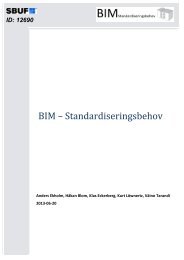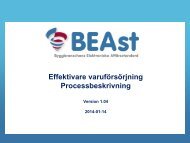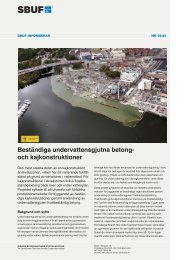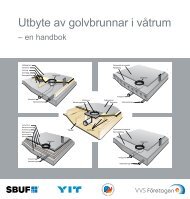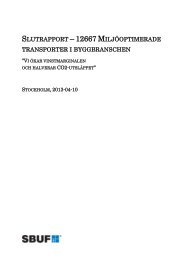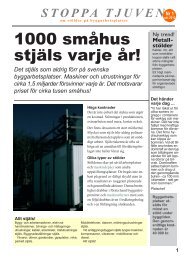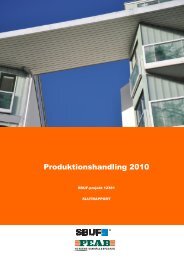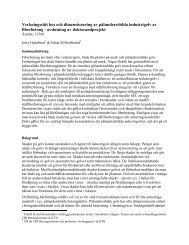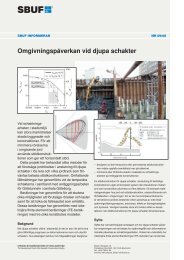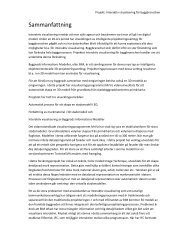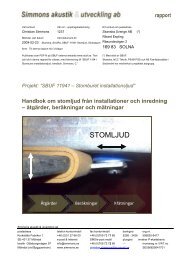Rapport SBUF-projekt: Mykotoxiner i inomhusmiljöer. Förekomst ...
Rapport SBUF-projekt: Mykotoxiner i inomhusmiljöer. Förekomst ...
Rapport SBUF-projekt: Mykotoxiner i inomhusmiljöer. Förekomst ...
You also want an ePaper? Increase the reach of your titles
YUMPU automatically turns print PDFs into web optimized ePapers that Google loves.
Hydrolysis and derivatization<br />
The hydrolysis and derivatization steps were performed<br />
mainly according to Nielsen and Thrane. 26 The sample extracts<br />
were evaporated under a gentle stream of nitrogen and<br />
hydrolyzed in 200 ml of 0.2 M methanolic NaOH, at room<br />
temperature, overnight. Samples were evaporated, 1.5 ml of<br />
distilled water was added, and tubes were vigorously vortexed.<br />
Approximately 1 ml of dichloromethane was added and tubes<br />
were vortexed again. Tubes were then centrifuged at 3200 rpm<br />
for 2 min and the dichloromethane phase was taken to new<br />
tubes and evaporated under nitrogen. The dried extracts were<br />
then subjected to either TMS or HFB derivatization. TMS<br />
derivatization was performed by adding 50 ml of derivatization<br />
mixture (MSTFA : TSIM : TCMS, 3 : 3 : 2, v : v : v) and 5 ml<br />
pyridine and heating the tubes at 60 1C for 30 min. Then, 45 ml<br />
of dichloromethane was added and samples were transferred<br />
to autosampler vials. HFB-derivatization was made by adding<br />
200 ml of acetonitrile-toluene (1 : 4, v : v) and 15 ml of HFBI<br />
followed by heating at 70 1C for 60 min. Then, samples were<br />
washed with 1 ml of sterile distilled water and the upper phase<br />
was transferred into autosampler vials. The derivatized samples<br />
were all stored at 4 1C pending analysis.<br />
GC-MS<br />
Samples were analyzed on a CP-3800 gas chromatograph<br />
equipped with a fused-silica capillary column (FactorFOURt,<br />
VF-5ms, 30 m 0.25 mm i.d., 0.25 mm film thickness) and<br />
connected to a 1200L triple quadropole MSMS detector (Varian<br />
Inc., Walnut Creek, CA, USA). Derivatives were analyzed both<br />
in EI mode, at an energy of 70 eV and an ion source temperature<br />
of 250 1C (TMS derivatives) or 200 1C (HFB derivatives), and in<br />
NICI mode with methane as ionization gas at a pressure of 0.8<br />
kPa and a source temperature of 200 1C. Volumes of 1–2 mlwere<br />
injected in the splitless mode with a helium carrier gas pressure<br />
of 69 kPa, using a CombiPAL autosampler (CTC Analytics<br />
AG, Zwingen, Switzerland). Column flow was 1.0 ml min 1 .<br />
The injector syringe was washed 6 times with methanol and<br />
toluene, respectively, before and after each sample injection. The<br />
temperature of the column was programmed from 90 to 280 1C<br />
at 20 1Cmin 1 ; the injector temperature was 280 1C and transfer<br />
line temperature was 280 1C.<br />
The MSMS conditions were optimized by repeatedly injecting<br />
0.1–1 ng amounts of standards at different collision energy,<br />
ion source temperature, and argon pressure in the collision<br />
cell. The parameters that gave the largest product ion peak<br />
area were selected. Detection sensitivity, defined as amount of<br />
standards injected with a signal-to-noise ratio 44 (software<br />
calculated peak-to-peak values), was determined by analysing<br />
derivatized standard preparations diluted in dichloromethane<br />
(TMS-derivatives) or acetonitrile–toluene (1 : 4, v : v) (HFBderivatives)<br />
injecting 0.1, 0.2, 1, 2, 10, 20, 100, and 200 pg in<br />
SIM and MSMS modes. Calibration was made by adding<br />
VER (0, 0.25, 0.5, 0.75, 1.25, 1.75, and 2.5 ng), TRID (0.0625,<br />
0.125, 0.1875, 0.25, 0.375, 0.5 ng), and 1,12-dodecanediol<br />
(internal standard, 1.25 ng in the case of VER and 0.25 ng<br />
in the case of TRID) in 0.5 ml-aliquots of methanol. Reproducibility<br />
was evaluated by preparing seven samples with 5 ng<br />
and seven samples with 0.5 ng of TRID and VER, plus 5 ng of<br />
the internal standard, in 0.5 ml-aliquots of methanol. All<br />
mixtures went through the sample preparation procedure,<br />
and each sample was injected three times.<br />
Results<br />
Standards<br />
Mass spectra of TMS- and HFB-derivatized VER and TRID<br />
standards are shown in Fig. 2. An overview of the precursor<br />
and product ions monitored, detector voltages and additional<br />
information, is shown in Table 3. In the following, detection<br />
limits have been expressed as injected amounts that gave a<br />
signal-to-noise ratio of at least 4 (peak-to-peak values).<br />
TMS derivatives of both VER and TRID showed excessive<br />
fragmentation. Ions used in SIM analysis of VER–TMS2 were<br />
m/z 320 (probably representing M–TMSOH), m/z 307<br />
(M–CH2OTMS), m/z 277 (M–CH2OTMS–2CH3), and m/z<br />
217 (M–CH2OTMS–TMSOH). The detection limit was difficult<br />
to determine since the derivative co-eluted with an unknown<br />
compound present in the blank. Fragment ions of m/z<br />
217 gave product ions of m/z 174 used for monitoring in<br />
MSMS; detection limit was 20 pg. Notably, other ions (for<br />
example m/z 320 and 277) gave excessive fragmentation in<br />
MSMS without any prominent product ions being formed.<br />
Ions used in SIM analysis of TRID–TMS were m/z 217<br />
(probably M–TMSOH–CH3), m/z 176, and m/z 161. Of these,<br />
m/z 176 gave best results in MSMS monitoring product ions of<br />
m/z 161. The detection limit was 10 pg both in MSMS and<br />
SIM (for all ions monitored).<br />
HFB derivatives analysed in EI mode produced abundant<br />
ions in the high mass range. Ions used in SIM analysis of<br />
VER–HFB 2 were m/z 445 (M–HFBO), m/z 444 (M–HFBOH),<br />
and m/z 416 (M–CH 2OHFB–CH 3). In MSMS, ions of m/z 444<br />
were fragmented, and product ions of m/z 123 were monitored.<br />
The detection limit both in MSMS and SIM was 10 pg.<br />
TRID–HFB gave abundant ions of m/z 446 (M) and m/z<br />
431 (M–CH3) used in SIM. In MSMS, fragment m/z 446 gave<br />
distinct product ions of m/z 431 that were monitored. The<br />
detection limit both in SIM and MSMS was 2 pg. HFB<br />
derivatives analysed in NICI mode gave very little fragmentation.<br />
The VER–HFB2 spectrum showed mainly ions of m/z<br />
638 (M–HF) and m/z 213 (HFBO); the former was selected for<br />
MSMS monitoring product ions of m/z 213. In SIM, m/z 638,<br />
m/z 302, and m/z 213 were monitored. In case of TRID–HFB,<br />
ions of m/z 426 (M–HF) were used both in MSMS monitoring<br />
product ions of m/z 159 (C3F5CO) and SIM. The detection<br />
limits both of VER and TRID were 0.1 and 0.2 pg in,<br />
respectively, MSMS and SIM.<br />
The peak area ratios of the mycotoxin standards/internal<br />
standard vs. the amounts of the mycotoxin standards in the<br />
samples followed the equations y = 0.5082x (VER, R 2 =<br />
0.998) and y = 0.3301x (TRID, R 2 = 0.959). The coefficient<br />
of variation was 5.3% (5 ng VER), 3.2% (5 ng TRID), 18%<br />
(0.5 ng VER), and 33% (0.5 ng TRID).<br />
Building materials and dust samples<br />
The building material and dust samples from water-damaged<br />
dwellings were analyzed for VER and TRID as HFB<br />
This journal is c The Royal Society of Chemistry 2007 J. Environ. Monit., 2007, 9, 151–156 | 153



